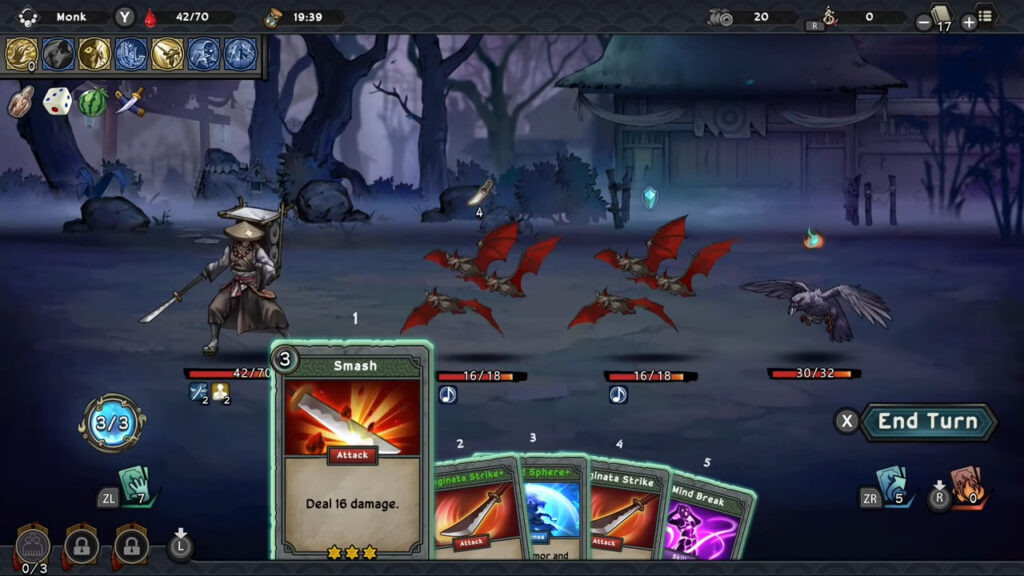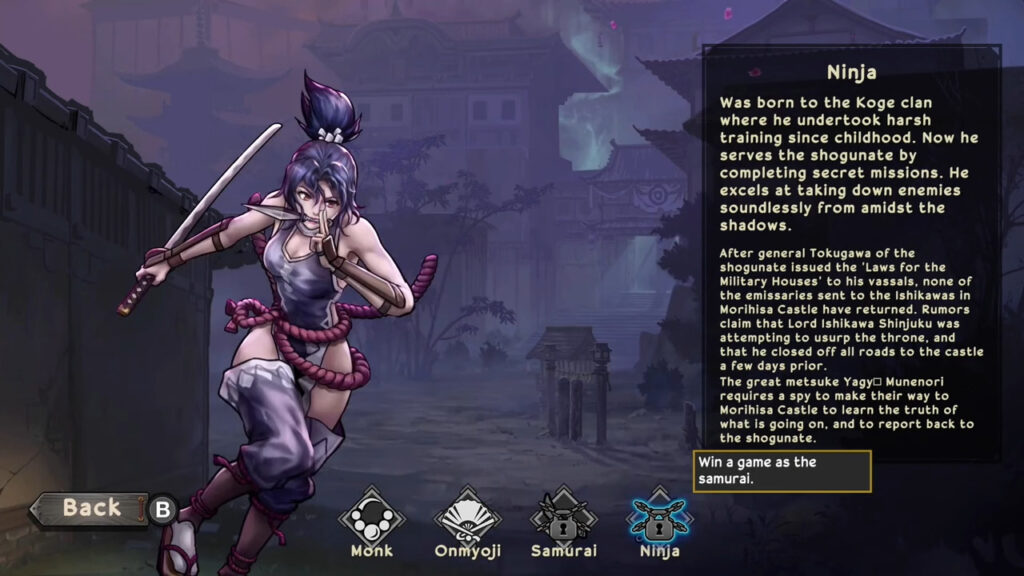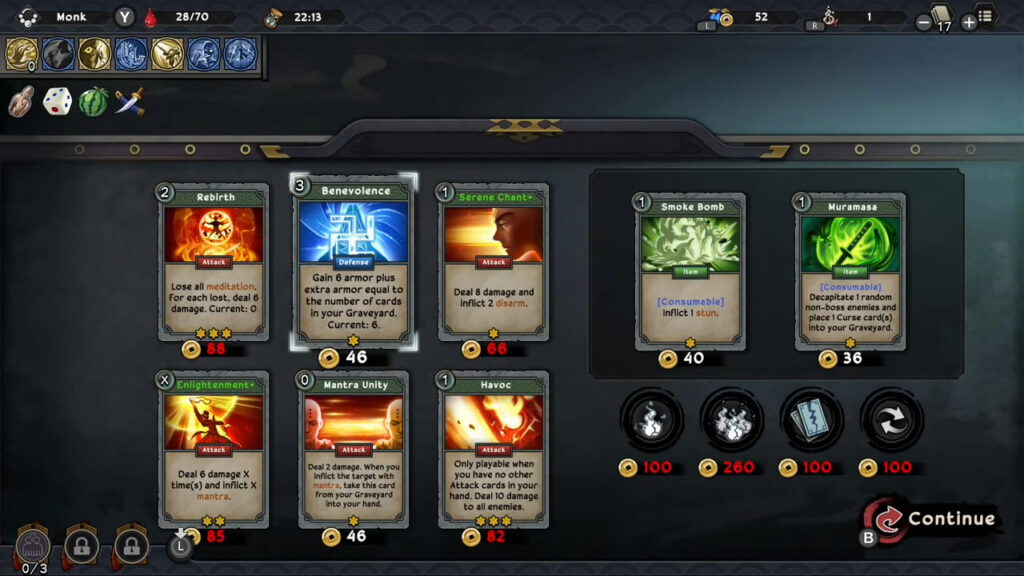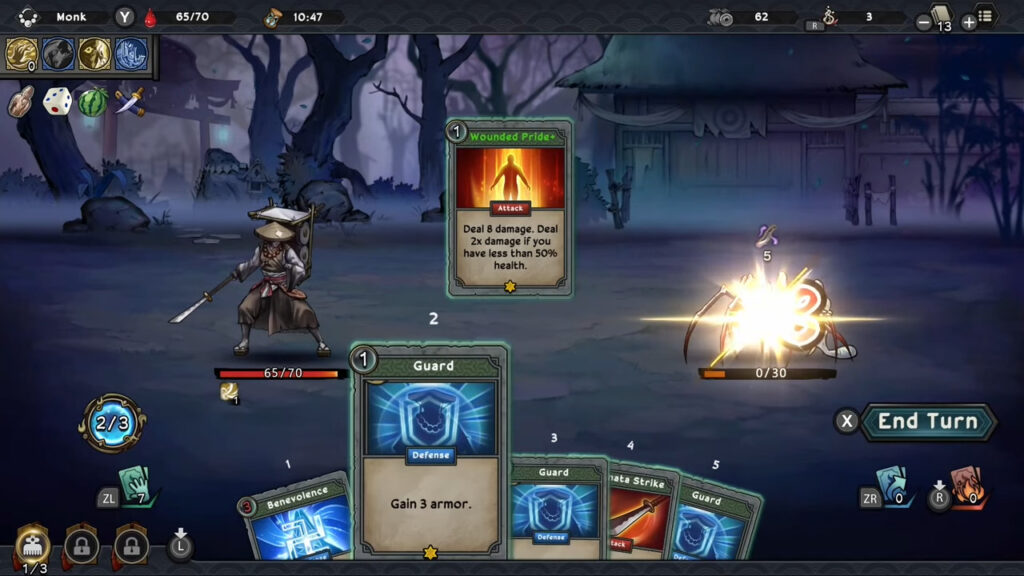
Developer: Smokingbear Studio
Publisher: Thermite Games
Platform: Switch, PC
Tested on: Switch
Castle Morihisa – Review
We quite enjoy deck building games, whether digitally or on the tabletop, so whenever a new title in the genre pops up, it has our attention. Such is the case with Smokingbear Studio’s Castle Morihisa, a title that combines roguelike deck building gameplay with Japanese folklore. The game certainly gets the presentation right, with lavish illustrations and an excellent soundtrack, but how does the gameplay fare?
Story
Despite Castle Morihisa embracing the aesthetics and the mythology of ancient Japan, there is no narrative arc in sight. Your chosen deck represents a specific class of character, which is represented by an on-screen avatar. Said character is seen on-screen wandering the lands and slaying demons from Japanese folklore, but we never find out who the avatar is or why they are doing this. While this does feel like somewhat of a missed opportunity, it didn’t overly bother us as this is a title that is centered mostly around delivering gameplay rather than an epic tale.
Graphics
The striking art style with heavy outlines used for the majority of Castle Morihisa certainly looks appealing, although perhaps not in line with what you’d associate with a game set in feudal Japan. The visuals look more like they came from an American comic book than from a manga. That said, the designs for enemies and player characters look fantastic and the only issue we had with Castle Morihisa’s visual presentation was with the animations, which look rough and janky. Character motion looks cheap and resembles paper doll-style animation.
Audio
Castle Morihisa’s OST feels very much in line with the music we’ve gotten to associate with feudal Japan thanks to films and games set in the era it represents. Whether or not this is historically accurate is not something we’re going to get into as we’re not experts on the subject, but we did feel like the music was one of the game’s highlights. The atmospheric soundtrack adds a sense of urgency to the card battles, and the crisp sound effects underline the actions that the player takes. There is no voice acting present here, which didn’t feel like a huge miss.
Gameplay
If you feel a sense of déjà-vu when looking at this roguelike deck builder, it’s not just you. It’s very blatant that Smokingbear Studio was inspired by the genre standard-setting Slay the Spire. Before you decry Castle Morihisa as a straight-up ripoff, however, we’re going to go ahead and say that although the game is definitely not as good as Slay the Spire, it actually holds its own and has the potential to provide a fun experience if you can get past some initial issues. We’re going to refrain from making too many comparisons to Slay the Spire too -we’ve made that point already- and instead look at what Castle Morihisa has to offer in a vacuum from a gameplay perspective.
You start out with two playable characters, each represented by a class deck, with additional character decks that can be unlocked as you progress through the game. The starting classes include the Monk, who focuses on defensive play, and the Onmyoji, who uses magic to defeat enemies. Later on, you’ll unlock the Samurai and the Ninja, and there is an additional “secret” class available as well. Each character certainly feels distinct and it takes a bit of trial and error to figure out which deck suits your personal playstyle. The game could have done a better job at explaining the specifics of each class instead of just the basics in the tutorial section, as we did feel lost for the first few rounds every time we tried out a new class.
A game of Castle Morihisa involves selecting one of the unlocked classes and then making your way to a boss battle across a map, encountering enemies and random events. Accompanying your character on this quest is a so-called fallen hero, a spirit that gives you a powerful boost that you can only use a limited number of times. You get to choose one of three fallen heroes at the start of a run, so you can tailor your playstyle accordingly. The main tool at your disposal is your trusty deck of cards, which is ever-evolving. After every enemy encounter, you obtain coins as well as a single card from a choice of three, so eventually, your deck grows and new powerful attacks become available. You’ll need these though, as Castle Morihisa isn’t an easy game. HP doesn’t recover in between rounds, and given how tough some of the enemies are, it’s easy to get overwhelmed and lose the game if you’re not paying attention.
Although your deck is your main tool, it’s not your only one. Apart from the aforementioned spirits, you’ll also gain points which you can spend on Talents that improve your character. These are purchased using Talent points which you get from defeating more powerful enemies, and although the Talent Tree is randomly generated with each run, the Talents themselves are class-specific. Random generation is a key element in Castle Morihisa: everything you encounter as you move across the map changes with each playthrough, and although the icons you select to move towards on the map give a rough indication of what to expect, you still need to get lucky as you won’t always have a campsite at your disposal to recover health. The randomized nature of the map means no two playthroughs are the same but it also feels unbalanced at times.
It takes a while for Castle Morihisa to really click, which unfortunately is the result of some poor design decisions. We don’t mind the difficulty level -which is brutal- but poor translations of some mechanics, and the game simply not explaining other ones at all, makes for a frustrating experience until you figure out on your own how some of the more obtuse elements of the game work. Adding insult to injury is that the descriptive texts that you do get don’t accurately explain the effects of a card in a comprehensive manner. Once you get past these mishaps, which takes time as well as a lot of trial and error, the game redeems itself and really begins to shine. It’s a shame that the barrier to start enjoying Castle Morihisa is so high, because fans of the roguelike deck-building genre will find plenty to love here if they can make it past the frustrating first few hours -and perhaps read up online about the game’s finer details. It becomes more difficult to recommend the game for newcomers, however, especially since there is a fantastic alternative out there that is simply superior in every way.
Conclusion
Castle Morihisa faces two issues that prevent the game from reaching true success. The first one, which can fully be blamed on Smokingbear Studio is that the game doesn’t put in the effort to get players to understand how everything works. Terrible descriptions of card effects don’t help here either, only adding to the frustration and confusion. It’s a shame because there’s a good roguelite deck builder underneath the initial layer of obtuseness. Castle Morihisa’s second issue is that it simply isn’t up there with Slay the Spire, which is the superior game in every single way. If you’re looking for something to scratch your deck-building itch after you’re done with Mega Crit Games’ offering, then Castle Morihisa might be up your alley, but otherwise, it’s a tough recommendation.
Castle Morihisa - Review,




 Smoki
Smoki



No Comments